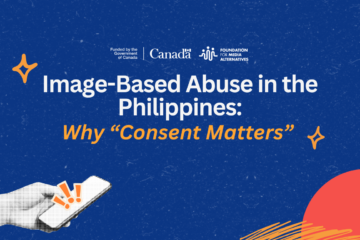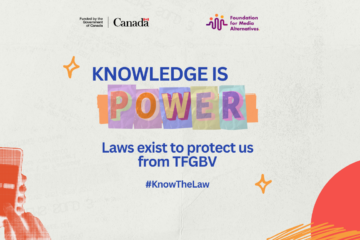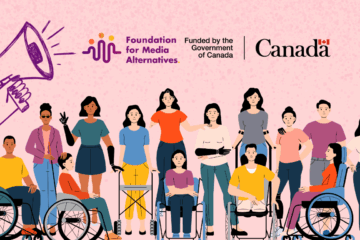#HijaAko and what the current data map on online gender-based violence in the Philippines is telling us
Published by Foundation for Media Alternatives (FMA) on
Digital, mobile, and social media have become indispensable to Fiipinos’ every day lives. We are heavy engagers of online media, spending around four hours and 12 minutes on different social media platforms and ten hours and two minutes on being online.
Now that the country is facing health crisis, more people are tend to stay at home and maximise all the benefits of technology such as video calling, shopping, reading news, streaming vlogs, and using hashtags both for the leisure and the campaign of it. Women, however, can have a distinct experience when it comes to being online especially as gender-based violence manifests in various ways when it comes to virtual spaces.
Gender-based violence using technology can go beyond sexist speech on a Twitter thread or Facebook post. The Association of Progressive Communications refers to online gender-based violence (OGBV) as “acts that are committed, abetted or aggravated, in part or fully, by the use of information and communication technologies (ICTs), such as phones, the internet, social media platforms, and email.”
Through the Take Back the Tech mapping tool, Foundation for Media Alternatives (FMA) was able to record 64 media reports of OGBV from January 1 to June 23, 2020 alone – a 30% increase from 2019’s total of 49 cases.
This first half of 2020, unauthorized use of photo and/or video was the top tech-related abuse at 22 out of 64 reports (36.07%). This is followed by 15 cases of violent threats/blackmail (24.59%) and 14 involving abusive comments (22.95%). Also among the reported incidents were:
- Deletion and manipulation of personal data (21.31%)
- Monitoring and tracking (14.75%)
- Repeated harassment (14.75%)
- Sharing and/or dissemination of private information (9.84%), and
- Unauthorized access of private data (4.92%).
Mobile phone was the most predominant ICT involved in incidents of OGBV (81.97%) followed by Facebook (50.82%) and online chats (44.26%) such as Messenger and Telegram. Videos (32.79%) were found to be a common material in these incidents while webcams (22.95%) were used most remarkably in cases of online sexual exploitation of children (OSEC).
National Capital Region (47.54%) has the most incidents followed by Central Visayas (21.31%), Central Luzon (9.84%), and CALABARZON (8.20%). Some cases had no specified location (8.20%). There were also reports from CARAGA (4.92%), SOCCSKSARGEN (3.28%) while 6.56% were combined reports from Eastern Visayas, Northern Mindanao, Cagayan Valley, and Davao Region.
While most of the perpetrators were strangers (70.49%), a number of cases reveal that aggressors personally know the women they attacked (49.18%). Groups of people (40.98%) also took part in the online violence as with the proliferation of child porn peddling in online private groups such as Telegram. Reports of harassment from State (6.56%) have also surfaced and of platform providers themselves (4.92%) whose flimsy security has aggravated women’s experience of online abuse. This includes Zoom which has been flagged by a women’s group, and Google Drive which many netizens found difficult to report after seeing a publicly accessible link containing women’s nudes, circulated without their consent.
The elusiveness of impersonation accounts
With predators turning online safety settings (such as anonymity options) to their advantage, women’s efforts to trace perpetrators are left in limbo. This is true for April* who has reached out to an online community after a dummy user hacked her boyfriend’s social media account and was able to access their intimate photos. After the hacker threatened to publicize their private materials, April sought the help of police but was later notified that catching the perpetrator would be “close to impossible” under the current circumstances.
Multiple impersonation accounts were reported to have appeared as well following the heavy dissent of quarantined netizens against the passage of Anti-Terror Bill amid the COVID-19 pandemic. During the height of online protests, many dissenters have found numerous fake accounts of them with some aggressors allegedly sending death threats to their namesakes. Among these were rape threats sent to women activists.
Various platforms have been trying to help users strengthen their online security. Twitter launched its notification service for gender-based violence. A contact form is also available for such cases as April’s where victims can tell Facebook Philippines if anyone on the platform is threatening to release anything a user intends to be private.
‘Hija Ako’
It can be dispiriting to individually battle violence online but ICTs are also tools to amplify progressive efforts with other users. This is evident in the recent trend of #HijaAko which was popularized after singer-songwriter Kakie Pangilinan called out a broadcaster on Twitter for blaming rape victims for the way they dressed.
The 65 year-old radio and TV broadcaster addressed the 19 year old celebrity ‘hija’ (young lady) as he explained his point but netizens, including Kakie, were quick to overturn the term that was used to insinuate her naivety and belittle her feminist stand. Users, more specifically young women, are now using #HijaAko to share their experiences of sexual assault as a form of holding ground while countering cybersexism and more forms of violence against women (VAW).
Young womens’ use of ICTs can be challenging. Data shows that majority of women who experience online aggression are aged 18-30 years (60.66%) while about 4 out of every 10 (42.62%) are under 18. While there are fewer reports from women survivors aged 31-45 years old (13.11%) and 46 and above (6.56%), all these experiences need to be looked into. Regardless of age, survivors constantly recover from emotional (96.72%), sexual (85.25%), physical harm (39.4%), as well as harm to reputation (26.23%).
Such grave effects should be a constant reminder for stronger pursuits of perpetrators or the lack of urgency can result to survivors not coming forward. Reporting to police (55.74%) remains the top action that survivors take. However, only 19 or 31.15% were reported to have pursued investigations, and only 9 (14.75%) were brought to trial. Twelve survivors reached out to State offices specialised in VAW. The same number reported the abuse to the service or platform provider of which the provider/platform took action against the aggressor in 25% of the cases. Others (4.92%) resorted to blocking the aggressor and leaving the online platform.
Simple on-site tactics can be helpful but blocking or filtering out violence does not stop an abuser from seeking out its next target. Much of gender-based violence online are essentially part of larger patterns of misogyny that need to be addressed offline. However, what one can do while engaged in these digital platforms is to use these very devices and applications to amplify women’s distinct experience. Translate that care reaction to the feminist movement and make technology systems a safe space for women and young girls. #



1 Comment
Online Gender-based Violence in the Philippines | Our Year-end Round-up Report | Foundation for Media Alternatives · February 19, 2021 at 8:00 AM
[…] continues to grow and even at an alarming rate in 2020. The first half alone saw a 30% increase. From 49 cases in 2019, the number grew to 64 in June […]